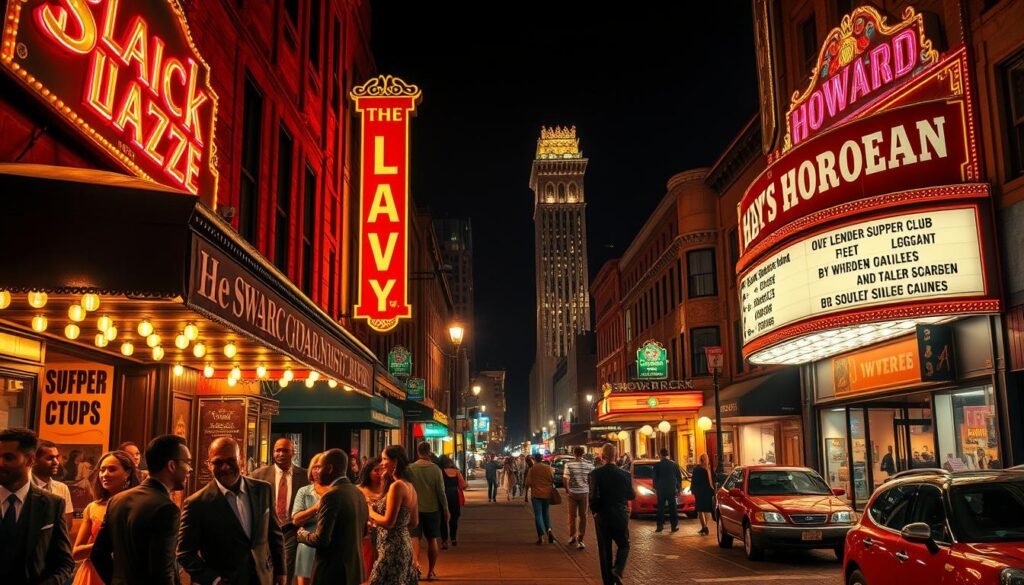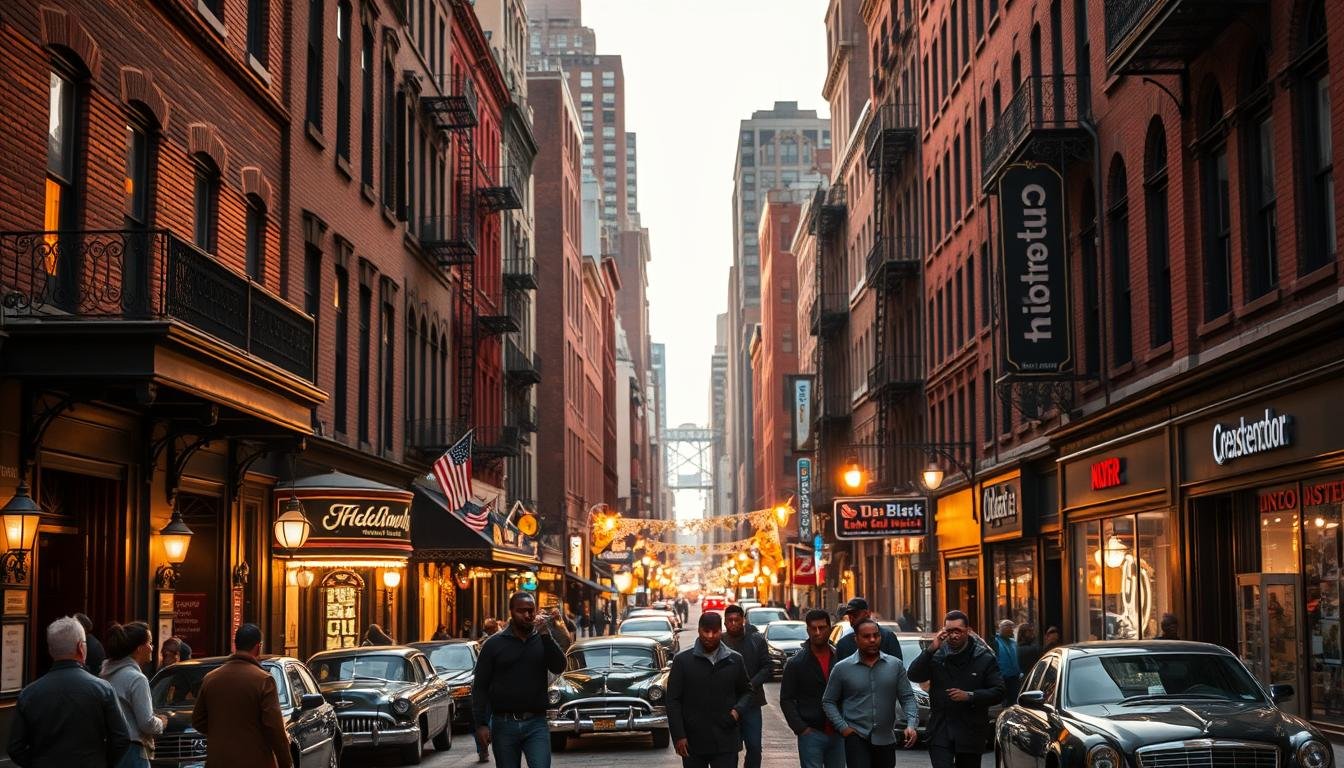The U Street Corridor Washington DC Black history is defined by more than a century of music halls, theaters, and Black-owned businesses that rose after the Civil War and boomed with streetcar lines in the 1880s.
The area grew between 1862 and 1900 with Victorian rowhouses and later earned protection as the Greater U Street Historic District in 1998. It became known as a national center for African American arts and enterprise, hosting venues such as the Lincoln Theatre and the Howard Theatre.
The story moves from Victorian growth to the heyday of “Black Broadway,” through decline after 1968, and into late-20th-century revival with transit and arts investment. Its institutions—clubs, theaters, and memorials—kept community life alive and shaped the city’s culture for the country.
Readers can explore a detailed walking tour and historical context via a curated guide to the neighborhood’s landmarks and events at this walking tour.
Key Takeaways
- The corridor emerged after the Civil War and flourished with 19th-century growth and streetcars.
- It earned a national reputation as “Black Broadway” with major theaters and clubs.
- Post-1968 decline gave way to revival through civic investment and transit access.
- Historic designation in 1998 helped protect architecture and community identity.
- The area remains a living cultural hub with festivals, memorials, and renewed arts venues.
U Street Corridor Washington DC Black History: Origins, Geography, And Early Growth
Following the American Civil War, Union encampments such as Camp Barker near 13th and R Streets drew newly freed people and seeded a vibrant community. Over time the military tents gave way to homes and local institutions.
From Post-Civil War Encampments To A Thriving African American Neighborhood
Horse-drawn streetcars on 7th, 9th, and 14th Streets—later converted to cable cars—made the area easy to reach. That transit link turned open fields into a desirable part of the city.
Streetcars, Victorian Rowhomes, And The Greater U Street Historic District
Between 1862 and 1900, rapid construction produced Italianate, Second Empire, and Queen Anne rowhomes. These houses and corner businesses created a dense, walkable neighborhood that supported social halls, churches, and shops.
By 1920 the population was predominantly African American, and the area’s built fabric shaped local culture for decades. Preservation efforts led to the Greater U Street listing on the National Register; read this National Register nomination for details.
Black Broadway’s Golden Years: Music, Businesses, And Community Life
For decades, music halls and businesses made the neighborhood a national center of African American culture. The Lincoln Theatre and the Howard Theatre hosted stars whose performances shaped American music. Duke Ellington and other jazz greats helped define genres that spread across the country.

Stages Of Stardom: Lincoln Theatre, Howard Theatre, And Jazz Legends Like Duke Ellington
The Lincoln opened in 1922 and the Howard in 1926. Both venues drew household names and launched careers. These stages gave artists a platform during years when many mainstream venues barred them.
Bohemian Caverns, Speakeasies, And A Nightlife That Shaped American Music
Bohemian Caverns and numerous clubs hosted late-night sessions and Prohibition-era speakeasies. Musicians rehearsed and innovated through long nights and busy days. The result was a steady flow of new jazz and popular forms.
Entrepreneurship And Finance: Industrial Bank And Hundreds Of Black-Owned Businesses
Industrial Bank, founded in 1934, provided capital when others refused service. Small businesses, hotels, and shops relied on local banking to grow. That financial backbone kept entrepreneurship alive and sustainable.
Icons, Institutions, And Leaders: Lillian Evanti, Charles R. Drew, Charles Hamilton Houston, And Thurgood Marshall
Artists and scholars mixed with legal minds and medical pioneers. Leaders in the arts and civil rights used local institutions to organize and advance national causes. Howard University’s proximity amplified that intellectual and cultural energy.
Community Hubs: Twelfth Street YMCA, Churches, Parades, And Cultural Traditions
The Twelfth Street YMCA, churches, and neighborhood parades acted as social anchors. They created a second home for residents and a space for civic planning and cultural celebration. Community life reinforced pride and mutual support.
Ben’s Chili Bowl And Culinary Landmarks That Endure
Ben’s Chili Bowl opened in 1958 and became a gathering place across generations. The restaurant and other eateries kept culinary traditions alive. They remain symbols of continuity and resilience at the heart of local life.
For a focused account of how this became known as Black Broadway, readers can explore detailed storytelling and archival context.
Turning Points, Resilience, And Revitalization From The 1960s To Today
The riots of 1968 triggered long-term decline, leaving scars on homes, shops, and daily routines. Violence at 14th and U killed 13 people and damaged roughly 1,200 properties. That shock accelerated disinvestment and drug activity through the 1970s and changed life for many residents.

1968 Riots, Population Shifts, And Decades Of Decline
After 1968 the area experienced population loss and weakened local businesses. Recovery stalled for decades as fewer services reached the neighborhood.
Memorials, Metro, And Renewal: African American Civil War Memorial And U Street Station
Public investment began to reverse some trends. The Reeves Center opened in 1986 as a redevelopment anchor.
In 1991 the U Street Metro station opened and the African American Civil War Memorial was dedicated. As a civil war memorial and war memorial, it honored United States Colored Troops and reasserted historical memory in public space.
Gentrification, Demographics, And The Return Of Arts, Culture, And Nightlife
From the 1990s onward theaters were restored and new housing arrived. The 1990s revival created both opportunity and tension as demographics shifted and gentrification reshaped who lived and worked here.
| Year | Event | Impact |
|---|---|---|
| 1968 | Riots and widespread damage | Accelerated decline for decades; residents displaced |
| 1986–1991 | Reeves Center; Metro station; Memorial dedication | Stabilized commerce; reinforced memory with a civil war memorial |
| 1990s–2010s | Rehab of theaters; new housing; HUD façade work | Revival of music and nightlife; gentrification altered demographics |
Leaders and organizations balanced preservation and growth while residents and advocates pushed for equity. For a detailed redevelopment report, see detailed redevelopment report.
Conclusion
A century of music, business, and civic leadership shapes the neighborhood’s present identity. The story of black broadway includes artists like Duke Ellington and civil rights figures such as Thurgood Marshall, whose work reached far beyond this area.
Institutions from Industrial Bank to community hubs provided a home for entrepreneurs and families through segregation and change. Landmarks like Ben’s Chili Bowl and restored theaters carry traditions forward day after day.
The street corridor stands as a living archive of civil rights and creative achievement. Readers can consult a detailed study and a look at building resilient enterprises then and now to learn more.
Today, the corridor’s legacy endures: preserved homes, public spaces, and cultural venues anchor community memory while inviting new audiences to steward this shared past.
